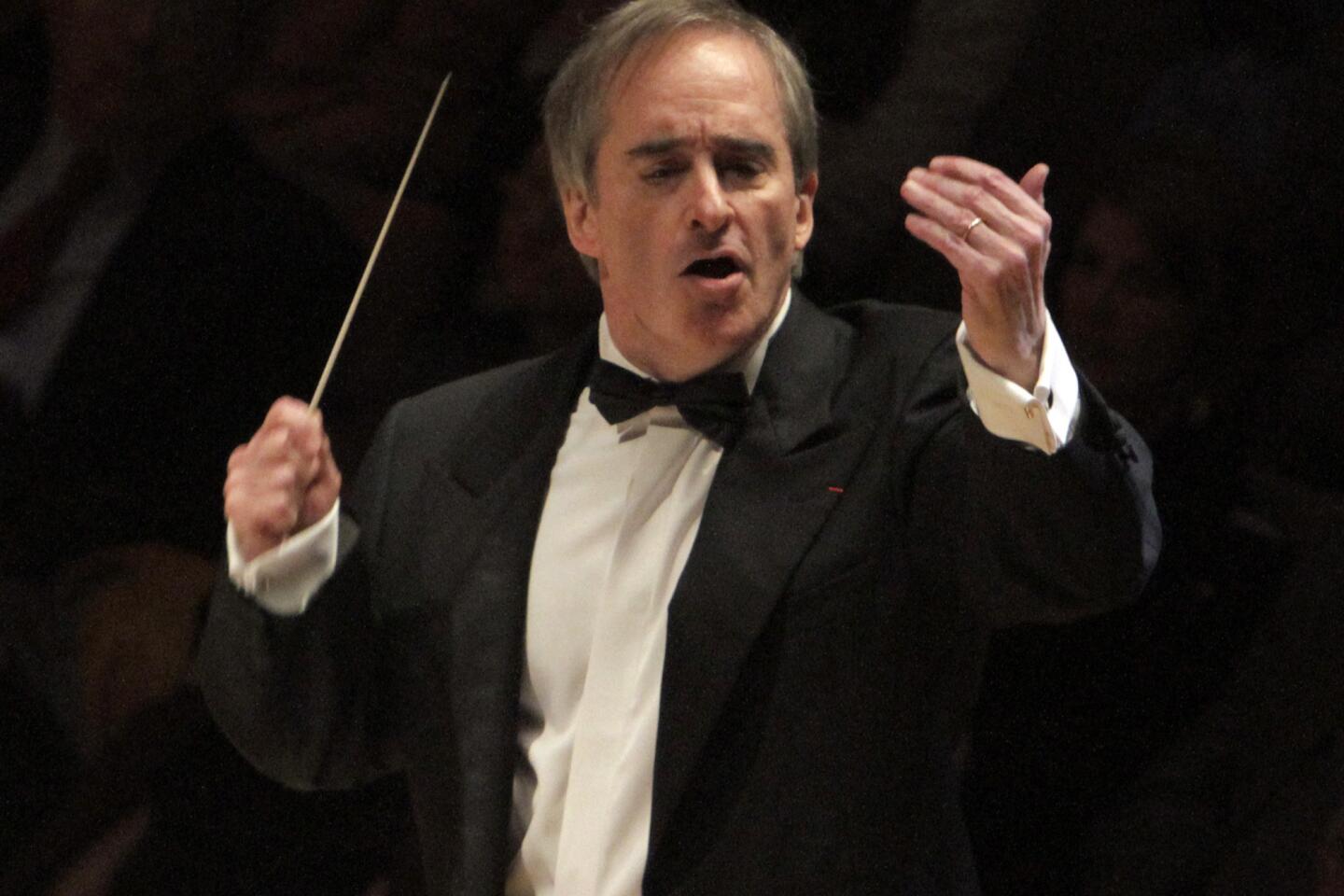Review: Benjamin Britten’s ‘War Requiem’ young again at Disney Hall
- Share via
Art has yet to stop war from exercising its horrifying folly. Still we try.
Premiered a half-century ago, Benjamin Britten’s “War Requiem” remains in wide currency, and with the anniversary of the British composer’s 100th birthday having been Friday, the work’s antiwar sentiment has been getting mass worldwide attention. Los Angeles took its turn Monday night at Walt Disney Concert Hall. The occasion was special.
James Conlon led a “War Requiem” with more than 400 student performers. The orchestra musicians were members of the Colburn Orchestra and USC Thornton Symphony. Singers were enlisted from California State University campuses in Long Beach and Fullerton, USC, the Los Angeles Children’s Chorus and the New Zealand Youth Choir (which happens to be on tour). Only the vocal soloists — soprano Tamara Wilson, tenor Joseph Kaiser and baritone Phillip Addis — and organist Christoph Bull were noted professionals.
The “War Requiem” was instantly recognized by the British press and public as a masterpiece of peace, an unmistakable reminder through viscerally unflinching music and poetry of the folly of war. A two-LP “War Requiem” recording, with the composer conducting, famously sold 200,000 copies in two months, and it has sold hundreds of thousands more since in every audio format known to man. Difficult and disturbing as the “War Requiem” is, it suits youth. The subject is the senseless brutality inflicted on the young in the battlefield. The great American chorus conductor Robert Shaw coached student performances throughout his career, and he produced a small army of antiwar protesters in the process, especially during the Vietnam War, when the work was fresh and new.
Britten’s most notable innovation in his 85-minute score is the angry insertion into the standard Roman Catholic mass for the dead unsettling battlefield poetry by Wilfred Owens, a British soldier in the First World War who died in uniform a week before armistice. Tenor and bass soloist sing settings of Owens’ text accompanied by a chamber orchestra. Orchestra, choruses and soprano soloist sing the Latin liturgy.
Britten, who died in 1976, wrote for a vast space, with a resonance acoustic maybe less immediate than Disney Hall’s. But the hall is ideal for the composer’s intention of separating orchestra, the chamber ensemble (which is often led by a second conductor) and the children. The different groups have different kinds of music and different functions.
CRITICS’ PICKS: What to watch, where to go, what to eat
Tenor and bass are like the ghost soldiers who have come back to haunt us for our sins of war, and the chamber ensemble’s music is harmonically and rhythmically unsettled and often downright spooky. This is the epitome of Britten’s operatic style that suits the individual at odds with obdurate society.
The big orchestra and chorus expose Death’s darkness and tremendous power. The children provide the obvious innocence and beauty war serves to undermine.
Conlon’s approach was toward unity. Rather than separate the chamber ensemble, he placed it in front of the main orchestra, so he could conduct everything. The soprano soloist, often given her own aerie, stood in the front row of the chorus. The children were, however, apart, placed on a high balcony opposite the orchestra. Britten suggested that the children have their own small organ, but the big Disney instrument served instead.
With a large army of inexperienced young performers, this made sense logistically, especially with the added complication of the same forces having performed the “War Requiem” at the acoustically very different Renée and Henry Concert Hall in Costa Mesa the night before. But the result was to make the score sound somewhat less strange than it might otherwise.
PHOTOS: Arts and culture in pictures by The Times
Conlon emphasized operatic grandeur and drama. The soloists sang with a feeling for sad, soaring beauty and eloquence. The choruses rang out with fabulous splendor. The orchestras were strong, but careful, and sweating it out when the rhythms became tricky in the shattering Sanctus.
The message here was, perhaps, meant to be more musical than political, more a celebration of Britten as composer than pacifist who was a conscientious objector during the Second World War. Even so, Conlon was hardly shy in exposing emotion, raw and bold.
Disney Hall was full but not with politicians. President Obama spent the evening fundraising in Beverly Hills. I wish he could have taken time out from filling his party’s campaign war chest to witness exalted young performers offering hope for the future of idealism and even, some distant day, peace. The “War Requiem” may not have ever stopped a single death. But it has not stopped trying and, as the spate of performances around the world indicate, we don’t want it to.
More to Read
The biggest entertainment stories
Get our big stories about Hollywood, film, television, music, arts, culture and more right in your inbox as soon as they publish.
You may occasionally receive promotional content from the Los Angeles Times.
















